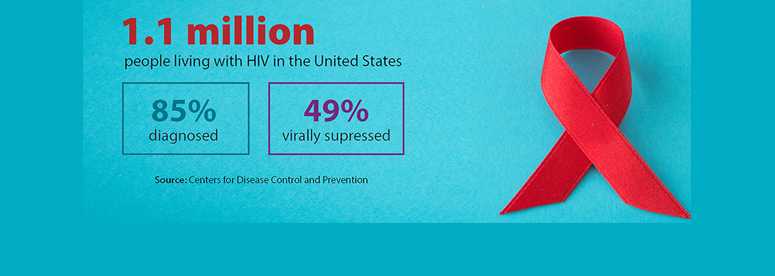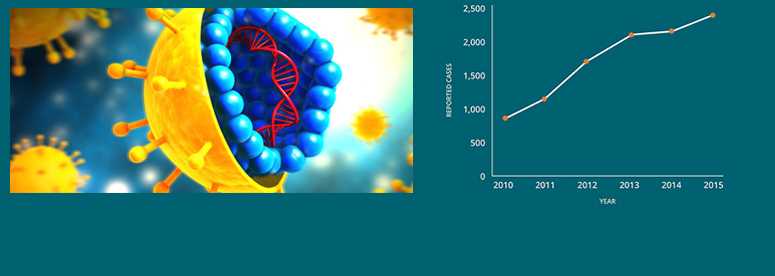Latest News & Announcements
CDC data released today show STD diagnoses at record high in U.S. – September 26, 2017
New CDC data show more than two million cases of chlamydia, gonorrhea and syphilis were reported in the United States in 2016, the highest number ever, according to the annual Sexually Transmitted Disease (STD) Surveillance Report released today.
CDC Releases New Data on the Connection between Health and Academics – September 7, 2017
CDC researchers analyzed data from the 2015 Youth Risk Behavior Survey (YRBS) to better assess the relationship between academic achievement and 30 health behaviors, including dietary, physical activity, substance use, sexual risk, violence-related and suicide-related behaviors. The results confirm that students with lower grades reported higher levels of health risk behaviors – and students with higher grades were more likely to report healthy behaviors.
Latest Data Show Increase in People with HIV Who have the Virus Under Control – July 27, 2017
CDC’s comprehensive analysis of the U.S. HIV care continuum shows that, based on the most recent national data from 2014, of the estimated 1.1 million people living with HIV in the United States, 85% knew they were infected, and about half (49%) were virally suppressed. The analysis also details differences in HIV diagnosis, care and treatment by age, race / ethnicity, transmission route, and sex.
New Hepatitis C Infections Nearly Tripled Over Five Years – May 11, 2017
New preliminary data released today shows that, in over just five years, the number of new hepatitis C infections reported to CDC has nearly tripled, reaching a 15-year high. The greatest increases, and the highest overall number of cases, were among young people 20-29, with injection drug use as the primary route of transmission. However, the majority (three-quarters) of the 3.5 million Americans already living with hepatitis C are baby boomers, born from 1945 to 1965, who are six times more likely to be infected with hepatitis C than those in other age groups and are at much greater risk for death from the virus.
Press Release | Full Report | MMWR | Media Summary | Graphics
Latest analysis of TB trends in US indicates progress is slow – March 23, 2017
New preliminary data of tuberculosis cases in the United States indicates progress is too slow to eliminate TB in this century.
2017 Conference on Retroviruses and Opportunistic Infections – February 15, 2017
CDC released estimates of the number of annual HIV infections (HIV incidence) in the United States – overall and by transmission group – at the Conference on Retroviruses and Opportunistic Infections on Feb. 14, 2017, in Seattle. These estimates provide the most up-to-date picture of HIV trends in the United States. Additionally, research from a joint study by The Rollins School of Public Health at Emory University and CDC suggests that for gay and bisexual men, pre-exposure prophylaxis (PrEP) for HIV prevention, along with testing for and treatment of sexually transmitted infections (STIs), can reduce not only HIV, but also some STIs, even in the presence of some reductions in condom usage.
Battling HIV in the African American Community – February 2, 2017
HIV diagnoses among African Americans have declined and gaps in disparity are closing, but improvements needed in testing and treatment services
CDC Vital Signs: HIV and Injection Drug Use – November 29, 2016
Use of syringe services programs has increased substantially during the last decade, but most people who inject drugs are still not using sterile needles consistently, according to a new CDC Vital Signs report.
Latest Data Show Increase in People with HIV Who have the Virus Under Control – July 27, 2017
CDC’s comprehensive analysis of the U.S. HIV care continuum shows that, based on the most recent national data from 2014, of the estimated 1.1 million people living with HIV in the United States, 85% knew they were infected, and about half (49%) were virally suppressed. The analysis also details differences in HIV diagnosis, care and treatment by age, race / ethnicity, transmission route, and sex.
2017 Conference on Retroviruses and Opportunistic Infections – February 15, 2017
CDC released estimates of the number of annual HIV infections (HIV incidence) in the United States – overall and by transmission group – at the Conference on Retroviruses and Opportunistic Infections on Feb. 14, 2017, in Seattle. These estimates provide the most up-to-date picture of HIV trends in the United States. Additionally, research from a joint study by The Rollins School of Public Health at Emory University and CDC suggests that for gay and bisexual men, pre-exposure prophylaxis (PrEP) for HIV prevention, along with testing for and treatment of sexually transmitted infections (STIs), can reduce not only HIV, but also some STIs, even in the presence of some reductions in condom usage.
Battling HIV in the African American Community – February 2, 2017
HIV diagnoses among African Americans have declined and gaps in disparity are closing, but improvements needed in testing and treatment services
CDC Vital Signs: HIV and Injection Drug Use – November 29, 2016
Use of syringe services programs has increased substantially during the last decade, but most people who inject drugs are still not using sterile needles consistently, according to a new CDC Vital Signs report.
2016 International AIDS Society Conference: New Research on HIV Risk Behaviors in Gay, Bisexual Male High School Students – July 20, 2016
New CDC data presented today at the International AIDS Conference in Durban, South Africa, suggests there are no significant differences in several HIV-related risk behaviors among male students in ninth through 12th grades who identify as heterosexual, gay or bisexual.
2016 Conference on Retroviruses and Opportunistic Infections – February 23-24, 2016
CDC researchers will be presenting findings from more than 40 studies in Boston, Massachusetts from February 22-25, 2016 on the latest developments in the prevention and treatment of HIV and related infectious diseases.
New Trends in HIV Care by Race – February 4, 2016
Despite the promising sign of declining HIV diagnoses over the past decade, new CDC findings demonstrate yet another persistent disparity that prolongs the epidemic among African Americans.
Press Release | Media Summary | MMWR | Fact Sheet | Graphic
CDC Statement on Syringe Services Programs – December 21, 2015
Statement from Dr. Jonathan Mermin, Director, CDC’s National Center for HIV/AIDS, Viral Hepatitis, STD, and TB Prevention, regarding Congress giving states and local communities the opportunity to use federal funds to support certain aspects of syringe services programs.
CDC data released today show STD diagnoses at record high in U.S. – September 26, 2017
New CDC data show more than two million cases of chlamydia, gonorrhea and syphilis were reported in the United States in 2016, the highest number ever, according to the annual Sexually Transmitted Disease (STD) Surveillance Report released today.
2015 STD Surveillance Report – October 19, 2016
New CDC data for three nationally reported STDs – chlamydia, gonorrhea, and syphilis – combined have reached unprecedented highs, and CDC calls for expanded prevention efforts in light of these increases.
Press Release | Full Report | Fact Sheet | Graphics | Audio
2016 STD Prevention Conference – September 22, 2016
This year’s conference focuses on identifying and transforming barriers into prevention opportunities. New data presented on Thursday, reinforce the risk of syphilis among gay and bisexual men. Additionally, an earlier press briefing, reported the occurrence of the first cluster of gonorrhea cases in the U.S. to show decreased susceptibility to both drugs that are the last available effective treatment option. Additional information on a promising new experimental oral antibiotic treatment was also discussed.
Press Release | Telebriefing Transcript | Fact Sheet | Speaker Bios | Study Summaries | Graphic
Latest data on Antibiotic Resistant Gonorrhea – July 14, 2016
New data released today find resistance to azithromycin, a first-line antibiotic in the treatment of gonorrhea, is emerging.
Press Release | Fact Sheet | Graphics | MMWR
STD Surveillance Report, 2014 – November 17, 2015
Annual snapshot of STDs finds that overall reported cases of chlamydia, gonorrhea, and syphilis are increasing.
Press Release | Full Report | Fact Sheet | Multimedia | Graphics
Increase in Congenital Syphilis – November 12, 2015
New data show sharp increases in reported cases of congenital syphilis between 2012 and 2014, pointing toward missed opportunities to screen and treat pregnant women.
Huffington Post Op-Ed Blog by Dr. Jonathan Mermin, NCHHSTP Director “The Too-Well-Kept Secret to Preventing STDs” – May 21, 2015
Latest analysis of TB trends in US indicates progress is slow – March 23, 2017
New preliminary data of tuberculosis cases in the United States indicates progress is too slow to eliminate TB in this century.
CDC Statement on USPSTF Latent TB Screening Recommendation – September 6, 2016
The U.S. Preventive Services Task Force issued a recommendation encouraging providers to test for latent tuberculosis infection in populations at increased risk.
Latest National Tuberculosis Trends – March 24, 2016
In advance of World TB Day (March 24), CDC has published new data about tuberculosis incidence in America.
Progress Slows as CDC and Public Health Partners Steer the U.S. Towards TB Elimination – March 19, 2015
In advance of World TB Day, CDC released preliminary national surveillance data for 2014 that reaffirms TB control is working, but also suggests progress is slowing, which is a reminder that TB should not be underestimated.
Media Summary | Fact Sheet | Graphics | Background Materials
Huffington Post Op-Ed Blog by Dr. Jonathan Mermin, NCHHSTP Director “Decades-old Tools No Match for Today’s Drug-Resistant TB“ – August 11, 2014
New Hepatitis C Infections Nearly Tripled Over Five Years – May 11, 2017
New preliminary data released today shows that, in over just five years, the number of new hepatitis C infections reported to CDC has nearly tripled, reaching a 15-year high. The greatest increases, and the highest overall number of cases, were among young people 20-29, with injection drug use as the primary route of transmission. However, the majority (three-quarters) of the 3.5 million Americans already living with hepatitis C are baby boomers, born from 1945 to 1965, who are six times more likely to be infected with hepatitis C than those in other age groups and are at much greater risk for death from the virus.
Press Release | Full Report | MMWR | Media Summary | Graphics
Increases in Hepatitis C Threaten Young Women and Babies – July 21, 2016
New analysis highlights the importance of screening all pregnant women for risk of hepatitis C and testing those at risk.
Press Release | Graphic | MMWR
Hepatitis C kills more Americans than any other infectious disease – May 4, 2016
New preliminary data released today finds that hepatitis C-related deaths are at an all-time high and more Americans now die as a result of hepatitis C infection than from the vast majority of other infectious diseases reported to the CDC combined.
Statement from John Ward, M.D., Director, CDC’s Division of Viral Hepatitis – March 9, 2016
The Report to the Nation on the Status of Cancer (1975-2012) released today shows a troubling increase in the number of Americans developing and dying from liver cancer, despite the fact that viral hepatitis – the primary cause of liver cancer – can be prevented and treated
CDC Statement on Syringe Services Programs – December 21, 2015
Statement from Dr. Jonathan Mermin, Director, CDC’s National Center for HIV/AIDS, Viral Hepatitis, STD, and TB Prevention, regarding Congress giving states and local communities the opportunity to use federal funds to support certain aspects of syringe services programs.
CDC Releases New Data on the Connection between Health and Academics – September 7, 2017
CDC researchers analyzed data from the 2015 Youth Risk Behavior Survey (YRBS) to better assess the relationship between academic achievement and 30 health behaviors, including dietary, physical activity, substance use, sexual risk, violence-related and suicide-related behaviors. The results confirm that students with lower grades reported higher levels of health risk behaviors – and students with higher grades were more likely to report healthy behaviors.
First National Study of Lesbian, Gay, and Bisexual High School Students’ Health – August 11, 2016
The first nationally representative study of U.S. lesbian, gay and bisexual high school students finds they experience substantially higher levels of physical and sexual violence and bullying than other students – and are at risk for several serious outcomes.
Press Release | Data Summary | Graphics | Responsible Reporting Guide | MMWR Access
Huffington Post Op-Ed Blog by Dr. Jonathan Mermin, NCHHSTP Director “Data Provide Insight to Improve Adolescents’ Health“ – October 6, 2015
International AIDS Conference 2014 – July 17, 2014
The 20th International AIDS Conference will take place from July 20-July 25. Throughout the conference, several CDC authors will present findings from their research in a number of topic areas, including a new analysis of trends in HIV testing and other HIV- and STD-related sexual risk behaviors among U.S. high school students.
Resources for News Media
Get Email Updates
Enter your email address to get updates about this site:
Calendar of Events
July 28: World Hepatitis Day
September 27: National Gay Men’s HIV/AIDS Awareness Day
- Page last reviewed: September 26, 2017
- Page last updated: September 26, 2017
- Content source:


 ShareCompartir
ShareCompartir







